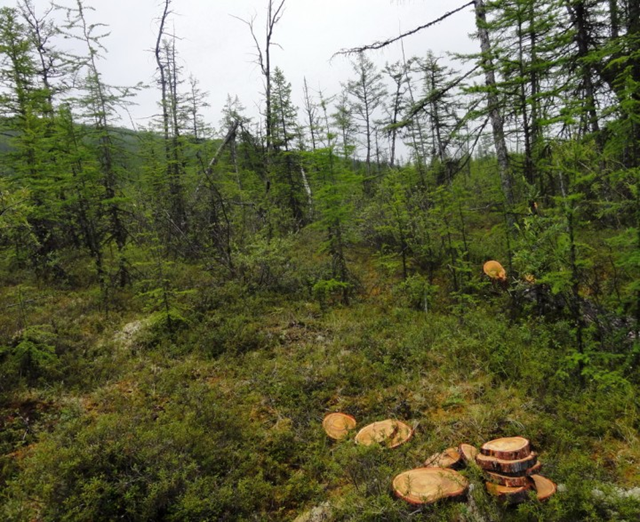Expedition finds frequency of Siberia forest fires is increasing
By Joanne Howl
15 August 2012 From Dr. Jon Ranson: […] But the common face of the forest can be summed in one word: change. Whether viewed from helicopter, boat, or on foot, huge areas of forest show the effects of fires. Some fires are recent, but most burned a couple of decades in the past. Because of how remote those forests are, and given the absence of people, most of these fires were likely caused by lightning. In many places the larch forest regrows, in some places it does not. We thought we understood how larch forests regenerated, but this change we’ve seen – some stands do not appear to be regenerating – certainly calls for study.
In any given area, there has been a trend for less time between fires – the fire return interval is changing. Professor Kharuk’s additional analysis on the fire scar samples will quantify this trend. Change is also occurring in the form of soil slumps and landslides as thawing permafrost allows whole hillsides of forest to slide down into the river. More subtle changes are the accelerated growth of individual trees in this area from the warming climate. Our field data should reveal and help quantify those changes. Our task ahead is to develop methods that take what we are learning about the larch forests in these central Siberia expeditions and apply it to the whole of the forest with aircraft and satellite remote sensing. Then we will know better the extent and the consequences of these changes. […]
From Dr. Slava Kharuk: […] But those tributaries were almost dried out: hot! It has been unusually hot … and so many forest fires, too. “Dry” thunderstorms caused fire ignitions over a millions hectares. The landscapes along the route were regenerating burns of different post-fire ages. We saw successions from seedlings embedded into “battle field” of mortal trees up to mature forests. The history of these “battles” was imprinted in burn marks on the surviving and dead boles. Warming-induced fire frequency increase may convert Siberian taiga from the sink to the source of carbon dioxide (at least at short time intervals). Also, fires promote larch domination, since conquered species are less fire-resistant. Warming also increases seasonal permafrost thawing depth and soil drainage, prolonging vegetation period, and, consequently, promotes an increase in larch growth. White-hot Arctic Circle sun irradiated energy is similar to Amazonian sun during polar days. But warming also provides opportunities for the “southern species” (Siberian pine, spruce, fir, birch, aspen) to migrate into larch habitat. In a changing climate, larch forests contain a number of challenging questions. To answer these questions, expedition studies and in-lab analysis are needed. […]
